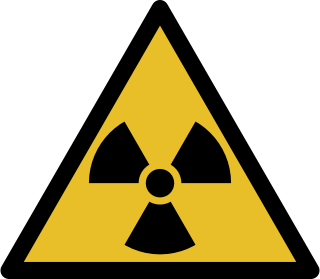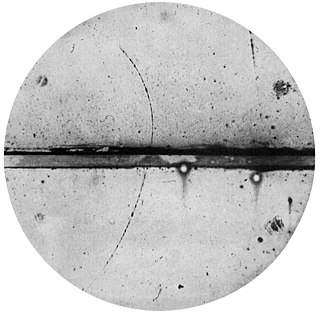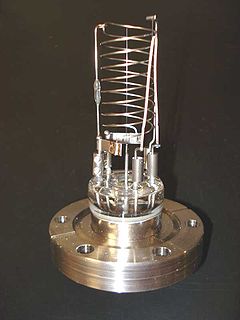
A Geiger counter is an instrument used for detecting and measuring ionizing radiation. Also known as a Geiger-Mueller counter, it is widely used in applications such as radiation dosimetry, radiological protection, experimental physics, and the nuclear industry.
A radiation dosimeter is a device that measures exposure to ionizing radiation. As a personal dosimeter it is normally worn by the person being monitored, and is a record of the radiation dose received. Older dosimeters, such as a film badge, require processing after use to reveal the cumulative dose received. Modern electronic personal dosimeters can give a continuous readout of cumulative dose and current dose rate, and can warn the person wearing it when a specified dose rate or a cumulative dose is exceeded.

The sievert is a derived unit of ionizing radiation dose in the International System of Units (SI) and is a measure of the health effect of low levels of ionizing radiation on the human body. The sievert is of importance in dosimetry and radiation protection, and is named after Rolf Maximilian Sievert, a Swedish medical physicist renowned for work on radiation dose measurement and research into the biological effects of radiation.

Ionizing radiation is radiation that carries enough energy to detach electrons from atoms or molecules, thereby ionizing them. Ionizing radiation is made up of energetic subatomic particles, ions or atoms moving at high speeds, and electromagnetic waves on the high-energy end of the electromagnetic spectrum.
The gray is a derived unit of ionizing radiation dose in the International System of Units (SI). It is defined as the absorption of one joule of radiation energy per kilogram of matter.
Radiation dosimetry in the fields of health physics and radiation protection is the measurement, calculation and assessment of the ionizing radiation dose absorbed by an object, usually the human body. This applies both internally, due to ingested or inhaled radioactive substances, or externally due to irradiation by sources of radiation.
In experimental and applied particle physics, nuclear physics, and nuclear engineering, a particle detector, also known as a radiation detector, is a device used to detect, track, and/or identify ionizing particles, such as those produced by nuclear decay, cosmic radiation, or reactions in a particle accelerator. Detectors can measure the particle energy and other attributes such as momentum, spin, charge, particle type, in addition to merely registering the presence of the particle.

A cloud chamber, also known as a Wilson cloud chamber, is a particle detector used for visualizing the passage of ionizing radiation.
Equivalent dose is a dose quantity H representing the stochastic health effects of low levels of ionizing radiation on the human body. It is derived from the physical quantity absorbed dose, but also takes into account the biological effectiveness of the radiation, which is dependent on the radiation type and energy. In the SI system of units, the unit of measure is the sievert (Sv).
The roentgen equivalent man is an older, CGS unit of equivalent dose, effective dose, and committed dose which are measures of the health effect of low levels of ionizing radiation on the human body.
Kerma is an acronym for "kinetic energy released per unit mass", defined as the sum of the initial kinetic energies of all the charged particles liberated by uncharged ionizing radiation in a sample of matter, divided by the mass of the sample. It is defined by the quotient .

The proportional counter is a type of gaseous ionization detector device used to measure particles of ionizing radiation. The key feature is its ability to measure the energy of incident radiation, by producing a detector output pulse that is proportional to the radiation energy absorbed by the detector due to an ionizing event; hence the detector's name. It is widely used where energy levels of incident radiation must be known, such as in the discrimination between alpha and beta particles, or accurate measurement of X-ray radiation dose.

The hot-filament ionization gauge, sometimes called a hot-filament gauge or hot-cathode gauge, is the most widely used low-pressure (vacuum) measuring device for the region from 10−3 to 10−10 Torr. It is a triode, with the filament being the cathode.
The F-factor, in diagnostic radiology, is the conversion factor between exposure and absorbed dose. In other words, it converts between the amount of ionization in air and the absorbed dose in tissue. The two determinants of the F-factor are the effective Z of the material and the type of ionizing radiation being considered. Since the effective Z of air and soft tissue is approximately the same, the F-factor is approximately 1 for many x-ray imaging applications. However, bone has an F-factor of up to 4, due to its higher effective Z.
Radiobiology is a field of clinical and basic medical sciences that involves the study of the action of ionizing radiation on living things, especially health effects of radiation. Ionizing radiation is generally harmful and potentially lethal to living things but can have health benefits in radiation therapy for the treatment of cancer and thyrotoxicosis. Its most common impact is the induction of cancer with a latent period of years or decades after exposure. High doses can cause visually dramatic radiation burns, and/or rapid fatality through acute radiation syndrome. Controlled doses are used for medical imaging and radiotherapy.
The Sievert integral, named after Swedish medical physicist Rolf Sievert, is a special function commonly encountered in radiation transport calculations.

The roentgen or röntgen is a legacy unit of measurement for the exposure of X-rays and gamma rays. It is defined as the electric charge freed by such radiation in a specified volume of air divided by the mass of that air. In 1928 it was the first international measurement quantity for ionising radiation to be defined for radiation protection, and was an easily replicated method of measuring air ionization directly by using an ion chamber. It is named after the German physicist Wilhelm Röntgen, who discovered X-rays.
The sievert is the SI derived unit of ionizing radiation dose








